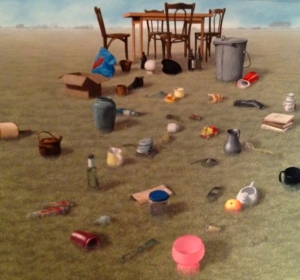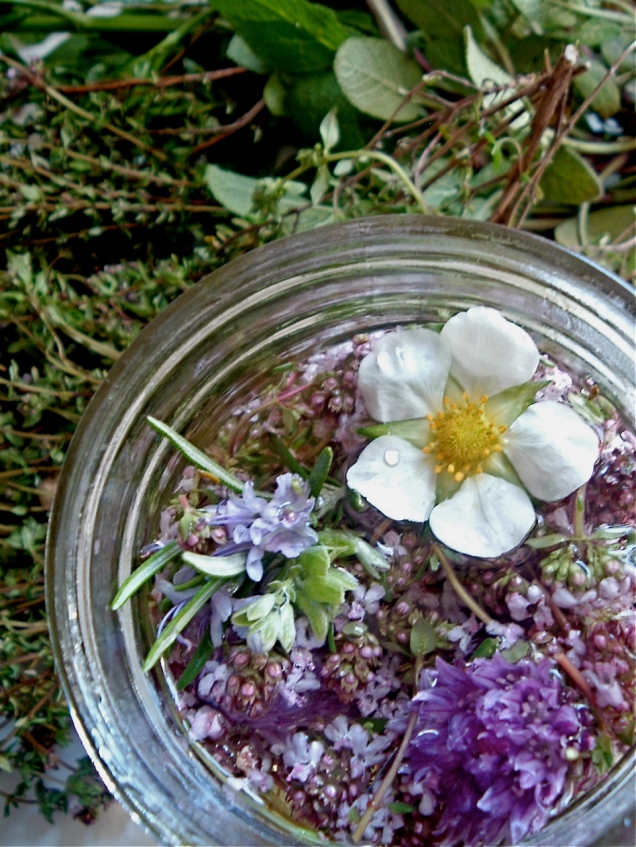 One wouldn’t think an herb so fragile and leafy as shiso (aojiso or ohba, sometimes labeled as perilla or beefsteak) would take kindly to salt, but it does. If you grew a plant or two this year, consider making the traditional salted pickle from Japan, or a shiso kimchi from Korea. Personally, I’m partial to the clean, simple flavor of the salted shiso, but have enjoyed both. Either lasts for several weeks to months in the refrigerator, but quality is best after at least a few days of curing.
One wouldn’t think an herb so fragile and leafy as shiso (aojiso or ohba, sometimes labeled as perilla or beefsteak) would take kindly to salt, but it does. If you grew a plant or two this year, consider making the traditional salted pickle from Japan, or a shiso kimchi from Korea. Personally, I’m partial to the clean, simple flavor of the salted shiso, but have enjoyed both. Either lasts for several weeks to months in the refrigerator, but quality is best after at least a few days of curing.
In Japan, red shiso (akajiso) is used as a dye for umeboshi, pickled plums, and a delicious addition to pickled cucumber or eggplant. It’s also dried and used as a furikake, or crumbly delicious crunchy topping for morning rice. Mmmm.
Why don’t I eat more Japanese breakfasts?
Because I don’t have a Japanese wife to make them, duh.
Ah, right.
Green shiso leaves are chiffonaded and mixed in with rice, or used to wrap bits of ground chicken breast and pork and grilled. I often pick a few leaves and eat them with rice, using them like those little nori strips that are now popular with the nutritionist crowd. The basil-anise-Thai basily green flavor is exquisite, and again I urge you to grow your own, as the stuff in the market is rare, expensive, and fades quickly. I’ve grown two kinds of the green shiso: one that has a purple underleaf, and one that doesn’t.
It is also preserved, most successfully with salt, but sometimes with soy and a little garlic. One can also use the seeds fresh or salted, but I scatter them in my herb bed for another crop.
The Korean form of shiso (kkaenip, sometimes called ‘sesame leaf’, Perilla frutescens var. frutescens) is a different strain of the Japanese perilla (Perilla frutescens var. crispa) and the ornamental perilla (coleus). See a good picture in the LA Times here. If you can find it, use it for kimchi.
The recipe couldn’t be easier. Pick the largest leaves of your fresh green shiso, then sprinkle a little sea salt on each leaf, stacking leaves in a container. You might weigh them down (as I did above, with ocean beach stones) or not. Let cure in the refrigerator for a few days, then enjoy for months.
Shiso Kim Chi
You will need to make a souse, but this recipe doesn’t ferment the kim chi like cabbage or radishes. It’s milder and softer, perfect for summer.
- 3 cups medium to large shiso leaves
- 3 tablespoons very thinly sliced red onion
- 3 cloves fresh garlic, minced
- 3 green onions
- 3 tablespoons julienne carrot
- 2 teaspoons sugar
- 2 tablespoons fish sauce
- 1 tablespoon powdered Korean red pepper
- 1 teaspoon sesame seeds
Prepare the shiso leaves by rinsing them, if necessary. Prepare the vegetables for the souse. Thinly slice the red onion and mince the garlic; thinly slice the whites and greens of the green onion; julienne the carrot. Toss the vegetables with the sugar, fish sauce, red pepper, and sesame seeds.
Layer every two shiso leaves with a bit of the sauce, gently rubbing it into the leaves evenly. Leave some souse for the top of the pile, press down gently, cover, and refrigerate for at least a week.
















You must be logged in to post a comment.